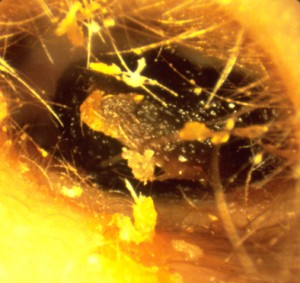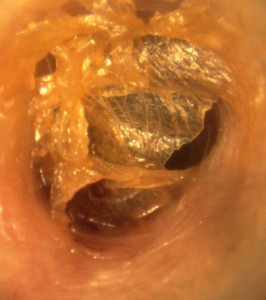Cerumen, more commonly called ear wax is a substance naturally produced by the ear, especially in the cartilaginous portion of the external auditory canal. The cartilaginous portion of the conduit has two types of glands: glands that produce cerumen ceruminous and sebaceous glands that produce sebum will mix with the wax. The mixture thus produced is also called cerumen. Ceruminous glands are large glands of a particular type that resemble sweat glands located under the armpit. They have the form of a long tube rolled into a ball which is coated inside of cells producing earwax. The outer wall of the tube is covered with muscle cells that can contract to evacuate the wax content in the gland. This secretion occurs particularly when touching the skin of the external auditory canal and in emotion.
Sebaceous glands like other body. They secrete sebum, an oily liquid, which will mix with the secretion of the ceruminous glands to form the so-called "liquid wax." This wax liquid extends on the walls of the conduit, normally only in the cartilaginous portion. Then it hardens and mixes with dead skin and hair detached to form the wax which is usually in the ears. The external auditory canal bone does not produce earwax. However, the part of the skin called keratin, gliding slowly toward the outside of the duct to renew itself, as a process of self-cleaning surface. This keratin will then be mixed with the wax to be discharged outside. This process of sliding outward also about keratin produced in the external auditory canal cartilage. The latter is also removed with the wax. There is schematically two types of earwax: the wax dry and wet earwax. Wet earwax (Figure 1) is most frequently seen in whites and blacks, while the dry wax (Figure 2) is more common among Asians.

Sebaceous glands like other body. They secrete sebum, an oily liquid, which will mix with the secretion of the ceruminous glands to form the so-called "liquid wax." This wax liquid extends on the walls of the conduit, normally only in the cartilaginous portion. Then it hardens and mixes with dead skin and hair detached to form the wax which is usually in the ears. The external auditory canal bone does not produce earwax. However, the part of the skin called keratin, gliding slowly toward the outside of the duct to renew itself, as a process of self-cleaning surface. This keratin will then be mixed with the wax to be discharged outside. This process of sliding outward also about keratin produced in the external auditory canal cartilage. The latter is also removed with the wax. There is schematically two types of earwax: the wax dry and wet earwax. Wet earwax (Figure 1) is most frequently seen in whites and blacks, while the dry wax (Figure 2) is more common among Asians.
 |


0 commentaires:
Enregistrer un commentaire